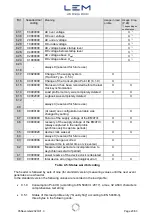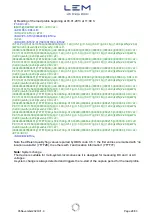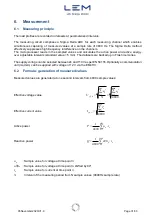
05November2020/V1.0
Page 18/33
4.2.3 Communication cycle
To explain the use of the message notions explained in the previous chapter, a communication cycle is given as
an example:
Request message:
with <xxxxxxxxxxx> = device address (optionally).
If no address is specified, any connected meter will answer
Acknowledgement/option select message:
with
Z = Communication baud rate
(0=300Bd, 1=600Bd, 2=1200Bd, 3=2400Bd, 4=4800Bd, 5=9600Bd),
Y = 0: switch to read mode
Y = 1: switch to programming mode
Password message (command message):
with
<n>
= 1: Password 1
<pppppppp> = Password
Programming mode:
Read
with
<obis> = OBIS code number of the parameters/profiles to read.
<p1> = time stamp beginning
<p2> = time stamp end
<e1..4> = OBIS codes of the energy registers to be included in the load profiles (no information
-> select all)
<e5>
= password, if necessary
Partial block reading
with
<edis> = OBIS code of the profile to read
<p1> = time stamp beginning
<p2> = time stamp end
<p3> = number of records per block
<e1..4> = OBIS code of the energy registers to be read (no information -> select all)
Write
with
<edis> = OBIS code of the parameter to be written
<p1> = parameter value
<e1> = password, if necessary
/?<xxxxxxxxxx>!<CR><LF>
<ACK>0ZY<CR><LF>
<SOH>P<n><STX>(<pppppppp>)<ETX><BCC>
<SOH>R5<STX><obis>([p1][;p2])[(e1)] [(e2)] [(e3)] [(e4)]
<ETX><BCC> [(e5)]<ETX><BCC>
<SOH>R6<STX><edis>([p1;p2][;p3])[(e1)] [(e2)] [(e3)]
[(e4)]<ETX><BCC>
<SOH>W5<STX><obis>([p1])[(e1)]<ETX><BCC>
















































